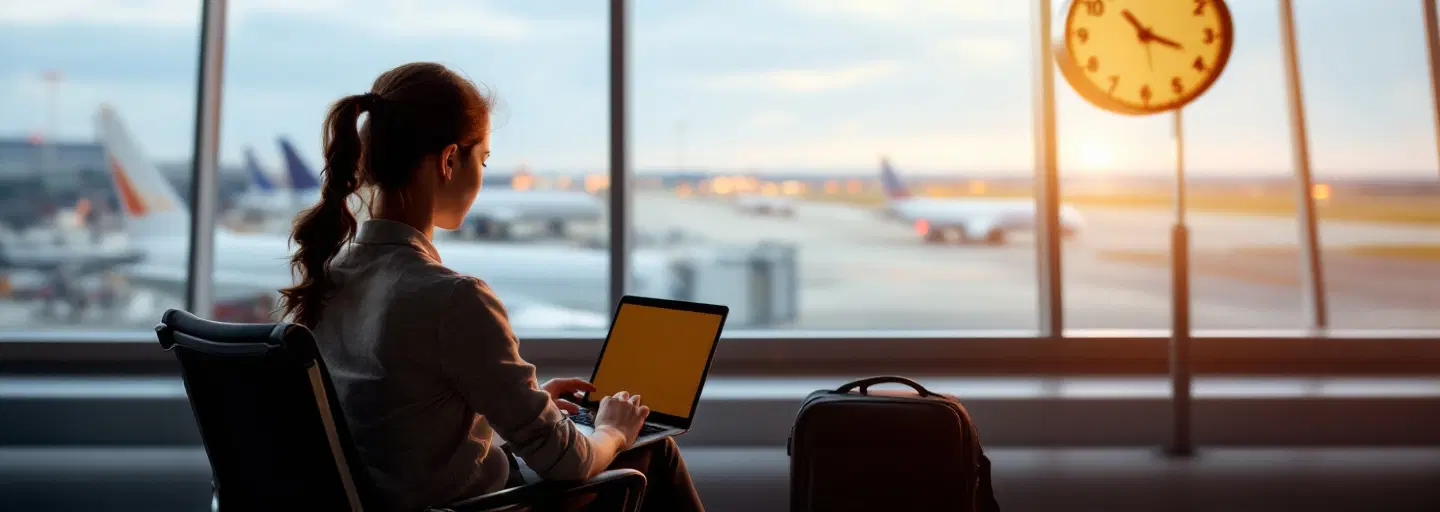How to Stay Productive While Traveling Across Time Zones
« Back to all blog postsLearn how to stay productive while traveling across time zones with smart planning, alarms, and time zone tools.

International business travelers cross an average of three time zones per trip.
This invisible shift does more than change the numbers on your watch—it fundamentally disrupts your ability to work effectively.
Why Time Zones Disrupt Your Productivity
Your body operates on an internal clock called the circadian rhythm. When you cross time zones, this biological timekeeper stays synchronized with your departure point while your watch adjusts to your destination.
This misalignment creates a biological confusion that directly impacts your work performance. Your brain struggles with basic cognitive functions when it expects sleep but receives daylight instead.
Decision-making abilities suffer significantly during this adjustment period. You might find yourself staring at simple emails, unable to craft coherent responses.
Memory and attention span decrease by up to 20% during the first days in a new time zone. Tasks that normally take 30 minutes might require an hour or more.
The practical consequences extend beyond feeling tired. You might miscalculate meeting times, miss deadlines, or struggle to participate effectively in video calls when your body believes it’s 3 AM.
Sleep quality deteriorates as your body fights between local time cues and its internal programming. Poor sleep further compounds focus problems, creating a cycle of diminishing productivity.
Energy fluctuations become unpredictable. You might feel alert during scheduled rest periods and exhausted during important presentations.
Use Time Zone Calculators to Plan Ahead
Time zone calculators eliminate the mental math that leads to scheduling mistakes. These tools visually display how your schedule translates across different locations, preventing confusion before it happens.
Start by mapping your personal productivity patterns against your destination time. If you’re most alert from 9 AM to noon at home, identify when this window occurs in your destination’s local time.
Create a visual timeline that shows your day across both locations. This dual view helps you spot potential problems, like realizing your team’s regular 4 PM check-in happens at 3 AM in your new location.
If you’re traveling from New York to Phuket , you can quickly see that when it’s 9 AM in New York, it’s already 9 PM in Phuket. This prevents scheduling a team call that would interrupt your dinner or evening rest.
Similarly, business travelers to Lagos can identify that the 5-hour time difference means their 2 PM client meeting at home would happen at 7 PM locally—potentially conflicting with evening plans.
Before departure, take these essential planning steps:
- Create a color-coded calendar showing both home and destination times for all scheduled commitments
- Identify your “overlap windows” when both you and colleagues at home are working
- Pre-schedule emails to arrive during recipients’ working hours
- Block out adjustment periods in your calendar when productivity will likely be lower
This advance planning transforms time zones from productivity obstacles into manageable differences. You’ll arrive with a clear understanding of how your schedule translates, eliminating the mental drain of constant time conversions.
Set Alarms to Sync with Local Time
Strategic alarm setting does more than wake you up—it helps reprogram your body’s internal clock. Your circadian rhythm responds to consistent cues, and alarms provide the structure needed to reset this biological system.
Start adjusting before you leave. Set alarms 15-30 minutes earlier each day for eastward travel (or later for westward) beginning three days before departure. This gradual shift eases your body into the new schedule.
Create a hierarchy of alarms based on energy management. Set “non-negotiable” alarms for must-attend events and “flexible” alarms for activities you can reschedule if adjustment is proving difficult.
Meal timing significantly impacts your body’s adjustment. Set consistent alarms for breakfast, lunch and dinner according to local time, even if you’re not hungry. This helps regulate hormones that influence your sleep-wake cycle.
Using preset alarms simplifies this process. You can establish a morning routine with alarms at 6:30 AM for hydration, 6:45 AM for light exposure, and 7:00 AM for breakfast—all helping your body recognize the start of a new day in local time.
For specific work needs, custom alarm times ensure you never miss critical deadlines. If you have a presentation at 3:30 PM local time but your body thinks it’s the middle of the night, a precisely timed alarm gives you 30 minutes to refresh and prepare.
The most effective alarm times for maintaining productivity while traveling are:
- Morning wake-up (consistent daily time based on local schedule)
- Mid-morning focus session (when natural energy often dips during adjustment)
- Pre-meal reminders (30 minutes before local mealtimes)
- Afternoon reset (to combat post-lunch energy slumps)
- Evening wind-down (signaling your body to prepare for sleep on local time)
These strategic alarms create external structure when your internal clock is unreliable, maintaining your productivity through the adjustment period.
Avoid Jet Lag with Smart Habits
Jet lag occurs when your body’s internal clock remains synchronized with your departure time zone while you physically exist in a different one. This misalignment affects hormone production, digestion, temperature regulation, and cognitive function.
Before traveling, prepare your body by adjusting sleep timing gradually. For eastward travel, go to bed and wake up 30 minutes earlier each day for several days before departure. For westward travel, do the opposite.
During your flight, stay well-hydrated but avoid alcohol completely. Alcohol disrupts sleep architecture and worsens dehydration at altitude, extending recovery time by up to 24 hours per drink consumed.
Immediately adopt destination meal times, even on the plane. Your digestive system provides powerful cues to your circadian rhythm. If it’s breakfast time at your destination, eat breakfast foods regardless of what meal is being served.
Upon arrival, manage light exposure strategically. For eastward travel, seek morning sunlight and avoid afternoon light. For westward travel, seek afternoon light and minimize morning exposure.
Use the timer feature to limit naps to exactly 20 minutes—long enough to refresh but not so long that you’ll disrupt your adjustment to local time. This prevents the common trap of “just closing your eyes for a minute” that turns into hours of off-schedule sleep.
The stopwatch feature helps time your light exposure sessions. Research shows that 15-20 minutes of direct sunlight (without sunglasses) provides optimal circadian reset benefits without risking overexposure.
These specific foods and substances impact jet lag recovery:
- Avoid: Caffeine after 2 PM local time, high-sugar foods, processed carbohydrates
- Consume: Tart cherries (natural melatonin), lean proteins, leafy greens, complex carbohydrates
- Limit: Dairy products (can cause digestive issues during adjustment)
- Increase: Water intake (aim for 8oz every waking hour)
- Consider: Ginger tea for travel-related nausea, chamomile tea for sleep support
These physical strategies complement the scheduling tactics from previous sections, addressing the biological aspects of time zone adjustment.
Stick to a Simple Routine on the Road
Routines provide stability when everything else changes during travel. Your brain conserves energy when it can predict patterns, making routines a powerful tool for maintaining productivity across time zones.
Create a morning routine with these portable elements that require minimal space or equipment:
- Two minutes of deep breathing before checking devices
- Five minutes of simple stretching beside your bed
- Writing three priority tasks for the day
- Drinking a full glass of water before coffee or tea
Structure your work sessions to maintain focus despite changing environments. The ideal travel work block includes 25-30 minutes of focused work, followed by a 5-minute movement break, and a location change every 2-3 hours to maintain alertness.
Set the Pomodoro timer for focused 25-minute work sessions in your hotel room, followed by 5-minute breaks to stretch or look out the window. This maintains your productivity rhythm regardless of what time zone you’re in.
Hotel rooms often lack proper workout facilities, but the circuit timer transforms any space into a gym. Set up a 7-minute circuit of bodyweight exercises (30 seconds each with 10-second transitions) to boost energy and focus when jet lag hits hardest.
Your evening wind-down routine is crucial for quality sleep in unfamiliar environments. Establish these consistent steps:
- Set out tomorrow’s clothes and pack work materials
- Spend 10 minutes reviewing tomorrow’s schedule
- Dim hotel room lights 30 minutes before sleep
- Avoid screens or use night mode settings
- Practice 5 minutes of relaxation breathing in bed
The power of these routines comes from their simplicity. Complex systems fail during travel, but these basic patterns can be maintained anywhere, providing structure when time zones disrupt your internal clock.
Quick Tips for Staying Focused While Traveling
Even with careful planning and solid routines, travel presents unique focus challenges. These rapid-fire tactics address specific productivity obstacles you’ll encounter on the road:
- Pack noise-canceling earbuds rather than bulky headphones. They take minimal space and create focus zones in noisy airports, hotels, and cafes.
- Bring a familiar scent (small essential oil or hotel-size lotion) to create environmental consistency that helps your brain focus despite changing surroundings.
- Download offline maps of your destination before arrival. Cognitive energy wasted on navigation depletes focus for important tasks.
- Use AlarmClockTab to set hydration reminders every 60 minutes during long flights. Dehydration reduces cognitive function by up to 15% at altitude.
- Pack a dedicated “focus object” that signals work mode—a specific notebook, pen, or even a small desk toy that creates a psychological trigger for concentration.
- Establish a 2-minute “reset ritual” to use between activities: close your eyes, take five deep breaths, and mentally state your next task before beginning.
- Use hotel “Do Not Disturb” signs strategically during your peak productivity windows, not just during sleep hours.
- Maintain a single digital document with all travel details (confirmation numbers, addresses, contacts) to eliminate the mental drain of searching for information.
- Schedule buffer time between meetings and work sessions that’s double what you’d allow at home. Time zone adjustment makes transitions take longer.
- Identify your “home base” upon arrival —a reliable café, hotel business center, or co-working space where you can return when focus falters in other locations.
These practical strategies complement your broader time zone management plan, addressing the moment-to-moment focus challenges that arise during international travel.

